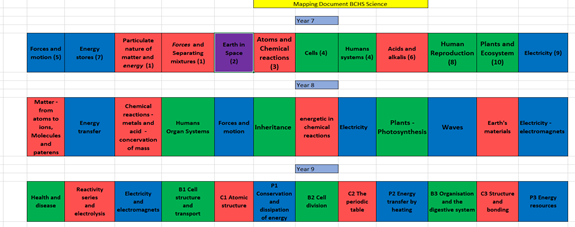Key Stage Three (KS3) – A Foundation for Powerful Knowledge
by Woody Dannan
Unquestionably, science is fundamental to the future and wider development of our local area, country, and the world- this is a fact that has been brought to the forefront of the public consciousness over the last year. It cannot be denied that developing a purposeful science curriculum is not only important for our future but a moral responsibility for science educators. At Birchwood, we take this duty very seriously so set ourselves the great task of redesigning our science curriculum starting from the very core of it- KS3.
I am personally very interested in the power of an ambitious KS3 curriculum and I feel that it has the potential to be the most important level in our students’ science education. I have always understood that, at its heart, KS3 must serve two very simple purposes: to build on KS2 and bring all students’ scientific knowledge to an equal level in year 7 whilst also building strong foundations for KS4. However, after researching extensively (the big ideas of science [1] as well as the seven recommendations from the education endowment foundation (EEF) [2] have been particularly useful), when you start to unravel the many strands that interweave to make a brilliant curriculum, it is clear that there are so many other layers and perspectives to consider. One of the most exciting elements is that a successful science curriculum must find meaningful opportunities to celebrate the beauty and contemporary relevance of science. It is evident that a thoughtful curriculum should give students an in-depth insight into the key content and knowledge as well the importance of science and how the study of science has real-world connections. Crucially, it should have regular opportunities for revisiting and retrieval and the order in which content is visited and revisited should be planned with careful consideration. In essence, when done right, KS3 can provide much more than a bridge between KS2 and KS4- it can ignite a passion for a subject that has the capacity to quite literally change society as we know it and create a solid platform of principles from which students can progress to further study and, most importantly of all, from which they can view and understand the world we inhabit.
With all of these ideas in mind, we knew that we needed to begin by focusing on helping students to retain the information they were being given in order to build that essential platform. We began by making two decisions: the first was to use the Best Evidence Science Teaching (BEST) resources [3] when sequencing and resourcing our KS3 schemes of learning with the aim to use the same resources in the future with KS4. BEST was chosen because of its evidence-based approach, the wealth of diagnostic questions that it offers which help teachers identify misconceptions as well as preconceptions and the brilliant response activities which could be used by teachers to these. The second decision was to incorporate careers into our curriculum in accordance with the Gatsby benchmark, in order to begin to provide that crucial real-world perspective 4 [4].
We set ourselves two years to accomplish the task, but by March 2020 and with the pandemic changing education in a way that we had never envisioned possible, it proved to be a very challenging task. Nevertheless, undeterred we virtually agreed to sequence our curriculum vertically (linking learning from year 7 to 11) as well as horizontally (across one academic year) where topics spire and students build on the knowledge gained from one topic in the next – and in each year they revisit core knowledge in order to add new knowledge onto it. This was the key – linking new knowledge to previous knowledge. Essentially, we aimed to use the research from the cognitive science to capitalise on revisiting information in a way that encouraged long-term storage of key ideas.
This notion of helping students to revisit and ultimately retain key concepts was interlinked with my understanding of building schemas. Over the last 3 years (and before gaining the post as head of science at Birchwood) I developed an interest in this and how it could support students in making sense of and retaining scientific knowledge. The first time I heard the term I genuinely believed that it was based on new research – I quickly learned that psychologists and cognitive scientists have been writing about this very topic longer than I had walked the earth! A schema is a way of organisation that happens to knowledge that we learn. Tom Sherrington states that schema is ‘organise ideas, knowledge, the things we learn, in patterns of connected information’[5]. For a schema to develop, we needed students to have a secure core knowledge that would be revisited and tested regularly, or it would simply be forgotten. The ideas around building schemas further corroborated the importance of sequencing our KS3 in a thoughtful and meticulous way.
Whilst reading the research and theories described above, I began to question established ideas in science education that I had never really considered before:
- Why do we teach cells first in year 7? Cells are complex – students are required to have a lot of prerequisite knowledge such as understanding of particles and chemical reactions in order to fully understand the role of certain organelles.
- Why do we teach about electrons in KS3 electricity topic without ever mentioning atoms and sub atomic particles?
With questions like this appearing more and more frequently in mind and in discussions with my fellow teachers, we became determined to carve a path that was rooted in research and evidence-based approaches on building schemas and helping students to store knowledge, rather than in what we had always done. It is worth saying that at this point that I am lucky to have joined Birchwood at the right time of the school’s journey to develop a knowledge-rich curriculum across all subjects. I have also been lucky to have a forward-thinking team of teachers who want to embrace change and take on a huge challenge of redesigning the science curriculum.
To make these ideas a reality, we read a lot of blogs, took part in may CPD sessions and listened to many talks on misconceptions, sequencing in science and how to plan students’ end point (the knowledge the students had to have by the end of the unit of learning) first. I also spoke to colleagues from STEM Network, Institute of Physics and specialists from the Royal Society of Chemistry before making a departmental choice to start our sequence with the unit ‘’particulate nature of matter’’ and not cells which is common practice in many science departments across the country. This is not to say that our plans are set in stone- quite the contrary, they are always evolving. However, the core values that we had at the beginning have not changed. Each unit of learning builds on knowledge that students have from previous units of study and the order in which this is done is the product of lots of discussion and careful consideration.
Here is an example of how we use what our students know to help them build schema.
|
Unit 1 Forces – Exist between matter. Anything with mass can exert a force on another object. |
Unit 2 Energy stores – energy is needed to overcome forces. But when a force moves an object energy is transferred. |
Unit 3 particulate nature of matter. Forces hold particle sin a solid in place – and when a solid is melted energy is needed to overcome the strong forces. |
Unit 5 atoms and chemical reactions – atoms are made from 3 subatomic particles. The electron is attracted (by a force) to the nucleus and energy is needed to remove that electron. Knowledge of electrons in needed in the electricity unit. And knowledge of particles and chemical reactions is needed when we students learn about cells. |
Table 1 – explaining sequence of knowledge in year 7units of learning.
Throughout the academic year we revisit knowledge through carefully planned retrieval practice at the start of each lesson and within each unit of learning. Our sequence also focuses on giving students a lot of practical skills as well as embedding literacy and numeracy. We believe that due to our carefully structured sequence, our students will remember more; new knowledge will be easier to understand and new information will be more likely to stick because they have a sound schema. Our next steps are to introduce more hinterland into the curriculum which will give science a greater meaning, more depth as well as make our curriculum far more diverse and inclusive. We know that the curriculum is never a finished produced – it should always be reviewed in pursue of excellence and we look forward to taking the next steps.

Table 2 – KS3 sequence of learning.
References:
[1]1 https://www.ase.org.uk/bigideas
[2] https://educationendowmentfoundation.org.uk/tools/guidance-reports/improving-secondary-science/
[3] https://www.york.ac.uk/education/research/uyseg/research-projects/bestevidencescienceteaching/
[4] https://www.careersandenterprise.co.uk/sites/default/files/gatsby_benchmark_4.pdf





